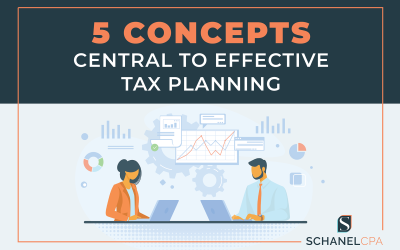
When planning major equipment purchases, business owners often face a crucial tax planning decision: whether to make the purchase this year or the next. This decision primarily revolves around several key factors, with the most significant being the tax rate differential between the two years. When tax rates are equivalent or similar, the decision becomes a time value of money problem.
To illustrate, let’s examine three scenarios.
Case Study: $100,000 Equipment Purchase
As of December 2023, a business needs to purchase equipment worth $100,000 no later than January 31 2024. The owner plans to fully expense the purchase amount in the year of acquisition using a Section 179 deduction. The question is: should the business owner make the purchase this year or early next year?
Scenario 1: Changing Tax Rates
When a significant change in tax rates is anticipated between years, the preferable year for purchase is typically the one with the higher rate.
Let’s assume the expected marginal tax rates are 24% in 2023 and 32% in 2024. If the equipment is purchased in 2023, the resulting tax savings would total $24,000 in April 2024. If purchased in 2024, the tax savings would total $32,000 in April 2025.
Despite having to wait to receive the tax break for an additional year, the significantly higher tax rate in 2024 makes it more advantageous to wait. By foregoing a $24,000 benefit this year in exchange for a $32,000 benefit a year later, the return on waiting is effectively 33%![1]
Scenario 2: Constant Tax Rates
But what if there is no difference in tax rates between the two years? Assuming a marginal tax rate of 32% in both years, the equipment purchase will generate tax savings of $32,000 regardless of the purchase date. The difference is in the timing.
If purchased on December 31 of 2023 rather than January 1 of 2024, the owner gains a $32,000 tax benefit in April of 2024, but forgoes a $32,000 tax benefit in April of 2025. But that one-day difference in the date of purchase means that the owner has access to the $32,000 in tax savings for an additional 12 months. At a minimum, that $32,000 could be invested in a high interest savings account at a 4% annual rate and earn $1,280 over the course of the year, or it could be used to reduce borrowing costs or be reinvested in the business.
Scenario 3: Constant Tax Rates but Purchase Can Be Delayed
But what if the business could delay the purchase beyond 60 days? At what point does it become worthwhile to delay purchasing?
Let’s assume the purchase can be delayed by six months until June 2024. While the owner forgoes the 2023 tax break and loses access to the $32,000 benefit until April 2025, the owner holds on to the $100,000 for an additional six months.
At 4%, that $100,000 can earn $2,000 in just six months. This benefit surpasses the $1,280 benefit we calculated in Scenario 2. Therefore, if delaying the purchase to June 2024 is feasible, it’s advisable to do so.
So where is the breakeven?
In the last scenario, the breakeven would be just under 4 months, or 3.8 months to be “exact”. In other words, the return the owner can earn on $100,000 at 4% for 3.8 months is $1,280, the same benefit derived from purchasing on December 31, 2023 versus January 1, 2024, as calculated in Scenario 2.
In fact, the breakeven point is determined by the tax rate, and the breakeven period in months can be calculated by multiplying the tax rate times 12 months. The higher the rate, the longer the breakeven period. If the tax rate is 24%, then the breakeven is 24% * 12 months or 2.88 months. If the marginal rate is 37%, then the breakeven point is 37% * 12 months, or 4.44 months!
Conclusion
In summary, when deciding to make an equipment purchase this year or the next, first consider the tax rates, and choose the year with the higher rate. If the tax rates are the same, it’s generally better to buy this year. However, if it’s possible to delay the purchase further into the following year, you will likely be better off delaying assuming you can hold off the purchase past the breakeven period – which is simply a function of the tax rate.
Please note that this analysis is intended as a general guide, not specific tax planning advice. There are other factors to consider beyond the math such an uncertainty, life circumstances, cash flow needs. If you require advice specific to you situation, please contact our offices.
[1] Calculated as follows: $8,000 benefit divided by $24,000.
Schanel & Associates is a CPA firm specializing in accounting, tax, and business valuation serving Palm Beach, Martin and St. Lucie Counties and beyond since 1993. Our CPAs and accounting professionals work with individuals, businesses, estates and trusts to provide everything you need under one roof. For more information, contact us today at 561-624-2118.



